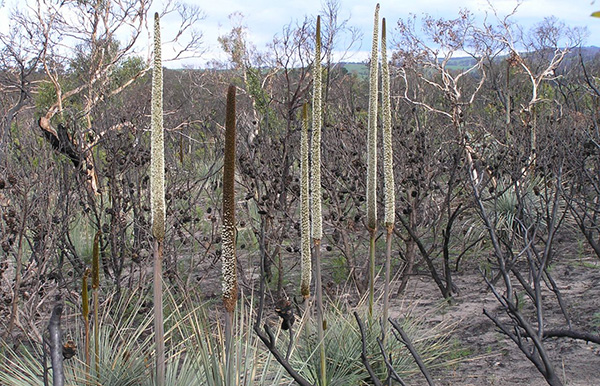
Xanthorrhoea semiplana subsp. semiplana flowering in Cox Scrub Conservation Park after fire. Photo: D. Murfet, SA Seed Conservation Centre.
Fire has been part of the Australian environment for a long time. Parts of the country have burned very regularly (such as grasslands, heathlands, savannahs), while other areas experiences fire rarely (e.g. tall mountain ash forests in Victoria), or almost never (e.g. rainforests in the tropics or some alpine areas in Tasmania).
Most Australian plants are fire-adapted and have strategies to cope with fire. Some re-sprout after fire, with green shoots bursting from blackened stems; for others, fire stimulates flowering, while other species take advantage of bushfires to germinate.
Well known examples of plants that survive fires well are:
- eucalypts – many taxa resprout from lignotubers or through epicormic shoots
- orchids – some species will flower profusely the year after a fire
- banksias – the cones of most species need fire to crack open to release the seeds
- grass trees – well known for their ability to quickly develop green leaves after fire and to flower soon afterwards.
There are also some fungi and mosses that will respond quickly to fires. However, there are also species that take a long time to recover or never do. For example, mistletoes and other epiphtes will not re-sprout when the host tree burns and many cryptogams (lichens, fungi & mosses) will take decades to re-establish important soil crusts.
Should fires occur too frequent, regeneration is also hampered, as the soil seed bank will be depleted. The severity of fires also affects the ability of plants to recover.
Post-fire landscapes need time to recover, so we need to adopt a “wait and see” approach. Often one, two or even three growing seasons are necessary to be able to establish, which species have recovered from fire and which ones not. While there will be much regeneration in the burned areas, identification of seedlings and young plants is very difficult and often botanists need to wait for these to flower to be certain of their identity.
Removal of weeds and prevention of weed spread is also very important to help native vegetation to thrive after a fire. But again, weed identification can be very difficult if there are only small seedlings present. Often, it may be better to wait until potential weeds grow larger or even until they start flowering, so their identity can be confirmed. This will prevent the “weeding” of native seedlings, i.e. of exactly the plants that we want to come back (see also AMLR fact sheet on woody weeds and fire; 2.3mb PDF).
More information can be found on our list of fire-related publications and websites. Soon, we will also post further blog articles about the fire response of certain species and groups of plants.
Compiled by State Herbarium botanist Juergen Kellermann.

